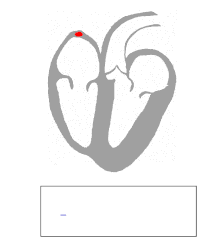Cabrera circle
With the help of the Cabrera circle , the type of electrical position of the heart can be determined using the recordings of a standard EKG . If the deflections of the limb leads are entered in the scheme, the type of position of the heart can be determined using direction vectors .
The type of position of the heart / the electrical axis of the heart
Since the heart functions as a large muscle based on the principle of electromechanical coupling , it must be electrically excited in order to contract (see heart ). The electrical heart axis corresponds to the main direction of propagation of the electrical excitation. This is routinely determined to evaluate an EKG for several reasons:
- Certain types of position must be considered pathological from the outset (e.g. over-turned right type)
- A change in the axis of the heart can indicate a heart condition such as a heart attack or pulmonary embolism (see below).
Location types
A distinction is made between the following types of location of the heart:
- overturned link type (<-30 °)
- Link type (−30 ° to + 30 °)
- possibly further differentiation in left type (−30 ° to 0 °) and horizontal type / transverse type (0 ° to + 30 °)
- Indifference type / norm type (+ 30 ° to + 60 °)
- Steep type (+ 60 ° to + 90 °)
- Right type (+ 90 ° to + 120 °)
- overturned right type (> + 120 °)
The electrically determined location types mostly correspond to the anatomical location types. But that doesn't always have to be the case.
Pathologies
Smaller changes in the type of posture are common with increasing age, when breathing in and out and during pregnancy, but particularly more pronounced changes in a short period of time indicate a pathological finding.
- The overtightened Links guy comes in the left anterior branch block , with left ventricular hypertrophy and atrial septal defects before.
- A left type is in patients aged 40–45 years. Age, with obesity and with left heart strain (e.g. arterial hypertension ).
- The indifference type is normal in adults and older adolescents.
- A steep type is physiological in adolescents and very thin adults and can otherwise be interpreted as an indication of a right heart strain ( cor pulmonale ).
- The right type is normal in children, otherwise an indication of right heart strain.
- An over-turned right type is always pathological (e.g. extreme right heart hypertrophy, left posterior hemiblock ).
literature
- Herbert Renz-Polster et al. (Ed.): Basic textbook internal medicine . Urban & Fischer, Munich 2004, ISBN 3-437-41052-0 .
- D. Novosel, G. Noll, TF Lüscher: Corrected formula for the calculation of the electrical heart axis. In: Croat Med J. 40 (1), 1999 Mar, pp. 77-79. PMID 9933900
Web links
- Entry on location type trainer in Flexikon , a wiki of the DocCheck company

